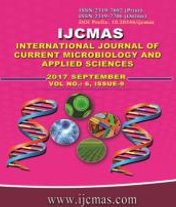


 National Academy of Agricultural Sciences (NAAS)
National Academy of Agricultural Sciences (NAAS)

|
PRINT ISSN : 2319-7692
Online ISSN : 2319-7706 Issues : 12 per year Publisher : Excellent Publishers Email : editorijcmas@gmail.com / submit@ijcmas.com Editor-in-chief: Dr.M.Prakash Index Copernicus ICV 2018: 95.39 NAAS RATING 2020: 5.38 |
A laboratory experiment was carried out to evaluate 26 groundnut genotypes for salt tolerance as well as to assess physiological basis for salt tolerance. Twenty seeds of each genotype were allowed to germinate for 72 hours at 28±1oC and then transferred to plastic beakers containing neutral sand. 7 days old seedlings were then subjected to different treatments viz. Control (plants receiving Hoagland nutrient solution adjusted to pH 6.3) and Salinity treatment (plants receiving Hoagland nutrient solution plus 200 mM NaCl adjusted to pH 6.3). The treatments were repeated on every third day and data were collected on 35-day old plants for different growth parameters. The tolerance index (expressed as Stress Responsive Index for total plant dry weight) of the genotypes ranged from 47.57% to 96.40%. Out of all the genotypes KDG-197 (TI 96.40%) was found to be the most tolerant under a salinity followed by R2001-2(TI 87.92%), VG-315 (TI 84.05%), TCGS1157 (77.59%) and TG 51(73.67%). While the genotypes Girnar3 (TI 47.57%), OG52-1 (TI 49.09%), TVG-0856 (TI 49.28%) and J86 (TI 50.66%) were the most susceptible genotypes based on their relative performance under stress in respect of total dry weight. The extent of reduction in sugar content in the five tolerant genotypes varied from 2.70%-49.82% over that of control while it was 51.83-70.32% for the four susceptible genotypes. Increase in leaf proline content over control recorded from tolerant and susceptible genotypes are 531.52-780.16% and 76.14 - 449.43% respectively. The extent of increase in protein content in the tolerant genotypes ranged from 34.25-144.01% over control. Among all the genotypes, Girnar 3 registered maximum increase (31.48%) in Electrolytic leakage (EL) of the leaf under stress.
 |
 |
 |
 |
 |